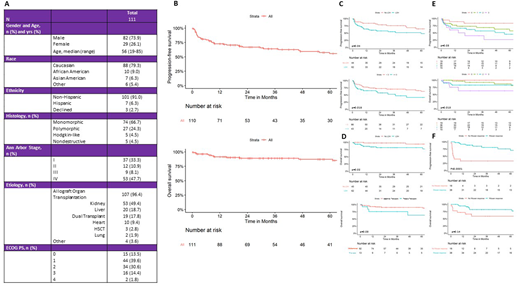Background
Patients treated with chronic immunosuppression face a six-fold increase in their cumulative lifetime risk of lymphoma relative to age-matched immunocompetent counterparts. These malignances represent a spectrum of lymphoid and plasmacytic histologies collectively referred to as post-transplant lymphoproliferative disorders (PTLD). Accurate risk-stratification and optimal treatment strategies are unclear given wide histologic and clinical heterogeneity. Current standard-of-care models include immunosuppression reduction and sequential, response-adapted chemoimmunotherapy platforms, however 80% of patients will require chemotherapy exposure. Overall response rates (ORR) are >90%, however relapse is common and serious treatment-related toxicities including infection and allograft rejection pose significant challenges. Several risk-stratification schemes have been proposed to direct initial therapy and predict clinical outcomes, however their external validity has been inconsistent across patient populations. We report here the results of a single-center retrospective study assessing the treatment patterns and outcomes of patients diagnosed with PTLD and provide a risk-assessment profile that may help improve clinical outcomes.
Methods
Patients with a diagnosis of PTLD were identified by Electronic Medical Records database query. Inclusion criteria were: age ≥ 18 years at the time of diagnosis, confirmation of PTLD by internal pathology review, primary diagnosis from 2008-2018, and receipt of therapy and surveillance care at Northwestern University in Chicago, Illinois, USA.
Exploratory univariate analyses were performed using Kaplan-Meier estimates with 95% confidence intervals and log-rank p-values for time-to-event outcomes; significance was set at p < 0.05. Response to treatment and disease progression were classified per provider-specific interpretations of clinical data as assessed by patient chart review. ORR is defined as complete or partial response. Progression-free survival (PFS) is defined as time from diagnosis to disease progression; patients who died before restaging or who were lost to follow-up were censored. Overall survival (OS) is defined as time from diagnosis to death from any cause; patients who were alive at last follow-up were censored.
Results
A total of 182 patients were identified by database query and 111 patients met our inclusion criteria. Demographics data are provided (Figure 1A). Five-year PFS and OS were 55.7% and 87.2%, respectively (Figure 1B). 92.6% of patients treated with immunosuppression agents underwent dose reduction and 16.8% experienced graft rejection, of which 27.8% required re-transplantation. Exploratory univariate analyses were performed on the following clinical factors: age, LDH, Ann-Arbor Stage, presence of extranodal disease, histologic EBER positivity, ECOG PS, comorbid conditions (type II diabetes, obesity, and coronary artery disease), CNS involvement, transplant type, presence of EBV viremia, and PTLD subtype. Established risk stratification models, including the IPI, R-IPI, Leblond score, Ghobrial score, and PTLD prognostic index, were applied to this cohort. We identified elevated LDH (p=0.04) and IPI score >3 (p=0.015) as predictors of PFS (Figure 1C); elevated LDH (p=0.02) and thoracic allograft transplantation (p=0.03) were predictors of OS (Figure 1D). The PTLD prognostic index significantly predicted PFS (p=0.03) and OS (p=0.013) (Figure 1E). 50.4% received Rituximab monotherapy prior to risk-stratification for combination chemoimmunotherapy; ORR and CR rates with Rituximab monotherapy were 67.9% and 41.1%, respectively. Overall response to Rituximab monotherapy was found to be a significant predictor of PFS (p<0.0001) but not OS (p=0.14) (Figure 1F).
Conclusions
This study represents one of the largest retrospective cohorts of PTLD patients to date. We show that the PTLD prognostic index is the most accurate risk stratification tool in predicting PFS and OS in this patient population and may have utility in guiding therapeutic approaches in PTLD patients. LDH, IPI score, and type of allograft transplantation are significant clinical variables in predicting clinical outcomes. Furthermore, response to Rituximab monotherapy was a significant predictor of PFS; improving frontline outcomes to high-risk patients remains a critical unmet need.
Winter:Epizyme: Other: DSMB; Delta Fly Pharma: Consultancy; Amgen: Consultancy; CVS/Caremark: Consultancy; Ariad/Takeda: Consultancy; Norvartis: Consultancy, Other: DSMB; Merck: Membership on an entity's Board of Directors or advisory committees, Other: advisory board; Karyopharm: Membership on an entity's Board of Directors or advisory committees, Other: advisory board. Gordon:Zylem Biosciences: Patents & Royalties: Patents, No Royalties. Karmali:BeiGene: Speakers Bureau; BMS/Celgene/Juno: Honoraria, Other, Research Funding, Speakers Bureau; Gilead/Kite: Honoraria, Other, Research Funding, Speakers Bureau; Takeda: Research Funding; Karyopharm: Honoraria; AstraZeneca: Speakers Bureau. Ma:AbbVie: Consultancy, Honoraria, Research Funding; AstraZeneca: Consultancy, Honoraria, Research Funding, Speakers Bureau; BeiGene: Honoraria, Research Funding, Speakers Bureau; Bioverativ: Consultancy, Honoraria; Genentech: Consultancy, Honoraria; Gilead: Consultancy, Honoraria; Janssen: Consultancy, Honoraria, Research Funding, Speakers Bureau; Kite: Consultancy, Honoraria; Pharmacyclics, LLC, an AbbVie Company: Consultancy, Honoraria, Research Funding, Speakers Bureau; Juno: Research Funding; Novartis: Research Funding; TG Therapeutics: Research Funding. Ganger:Mallinkrodt: Consultancy; Gilead: Speakers Bureau. Pro:Verastem Oncology: Research Funding.
Author notes
Asterisk with author names denotes non-ASH members.


This feature is available to Subscribers Only
Sign In or Create an Account Close Modal